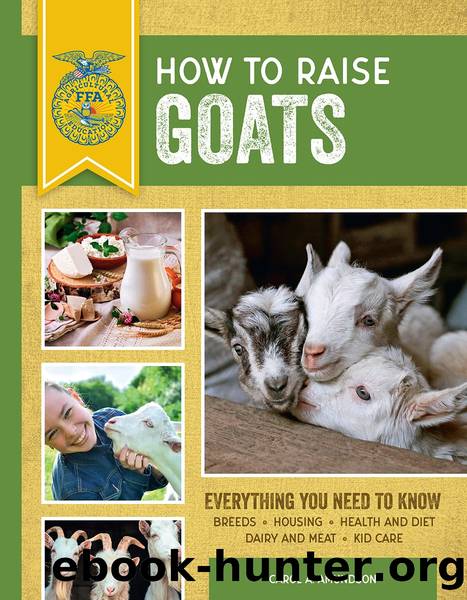How to Raise Goats:, Everything You Need to Know: Breeds, Housing, Health and Diet, Dairy and Meat, Kid Care by Carol A. Amundson

Author:Carol A. Amundson
Language: eng
Format: epub
Publisher: Voyageur Press
Published: 2019-01-15T00:00:00+00:00
NEUTERING UNWANTED MALES
Neutering isnât a pleasant task. However, it eliminates the characteristics that make bucks objectionable, such as odor and breeding behaviors. Wethers make excellent companions or working goats. In meat herds, wethers reduce rut behaviors. Fiber-goat wethers have cleaner fiber. Neutering can also extend the goatâs lifespan, since wethers do not go through the stress of rut every fall, which tends to make bucks shorter-lived on average compared to other goats.
Bucks are usually born with their testicles descended. While neutering is possible even at a few days of age, some breeders choose not to castrate until the animal is eight to twelve weeks old. This allows the urethra time to develop and may help prevent urinary calculi problems laterâalthough other reports indicate that the age at neutering is a less important factor than the animalâs diet.
Ethical and market considerations should be taken into consideration when deciding on your farmâs neutering philosophy. In meat animals, some buyers require intact animals, while others prefer wethers. Some sellers do not allow any nonbreeding male to leave the farm without neutering. This keeps unsuitable genetics from entering the gene pool as well as preventing new owners from unwittingly purchasing a pet goat that later turns into a stinky, unpleasant menace.
Methods of neutering include cutting the scrotal sac and removing the testicles, crushing or âcrimpingâ the spermatic cord with an instrument known as an emasculator (Burdizzo), and banding the testicles with an elastrator band.
On our farm, we typically castrate by cutting the male kids at a young age when their testicles are still small. Banded kids seem to be in distress longer than those that are cut or crimped. Some European countries consider banding inhumane and have made it illegal. Because the scrotal sac actually rots off, this technique has the highest risk of infection.
Some breeders give pain medication prior to performing castration or other traumatic procedures. Oral pain meds are poorly absorbed by goats, but a regular aspirin given at the dose of one tablet per 10 pounds or oral Banamine at 1 milligram per pound may be given a few hours before the procedure. An injection of Banamine can be procured from a vet and given a half hour before cutting or crimping. Fias Co Farm in Tennessee sells an herbal painkiller known as Ow-eze on its website. Some other breeders use willow branches for the natural salicylates that act similarly to aspirin. Be aware that aspirin can reduce blood clotting and might lead to extra bleeding after surgical castration.
Most large herd operations castrate their own male kids, but veterinary help may be preferable for specific cases or smaller herds. The vet has sedation available. Full-size bucks may be neutered by crushing the spermatic cord with a Burdizzo.
Download
This site does not store any files on its server. We only index and link to content provided by other sites. Please contact the content providers to delete copyright contents if any and email us, we'll remove relevant links or contents immediately.
| Antioxidants & Phytochemicals | Caffeine |
| Cancer Prevention | Fiber |
| Food Additives | Food Allergies |
| Genetically Engineered Food | Macrobiotics |
| Vitamins & Supplements |
Nutrition for Sport, Exercise, and Health by Spano Marie & Kruskall Laura & Thomas D. Travis(3243)
Nutrition for Sport, Exercise, and Health by Marie Spano & Laura Kruskall & D. Travis Thomas(3240)
The Sprouting Book by Ann Wigmore(3058)
Flavor Flours by Alice Medrich(2347)
Memory Rescue by Daniel G. Amen(1970)
Superfood Smoothie Bowls: Delicious, Satisfying, Protein-Packed Blends that Boost Energy and Burn Fat by Chace Daniella(1918)
The Bad Food Bible by Aaron Carroll(1895)
Dirty Genes by Ben Lynch(1863)
The Main Street Vegan Academy Cookbook by Victoria Moran(1704)
Genius Foods by Max Lugavere(1704)
The Poisoner's Handbook by Deborah Blum(1666)
Good Calories, Bad Calories by Gary Taubes(1662)
The I Quit Sugar Cookbook by Sarah Wilson(1630)
Core Performance Essentials by Mark Verstegen(1625)
Memory Rescue: Supercharge Your Brain, Reverse Memory Loss, and Remember What Matters Most by Amen Dr. Daniel G(1576)
Big Girls Do It Stronger by Jasinda Wilder(1572)
Android App Development by Franceschi Hervé J.;(1500)
Sugar Crush by Dr. Richard Jacoby(1468)
Dr. Colbert's Keto Zone Diet by Don Colbert(1324)
